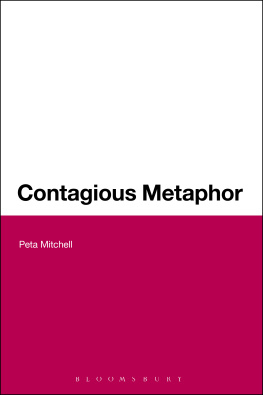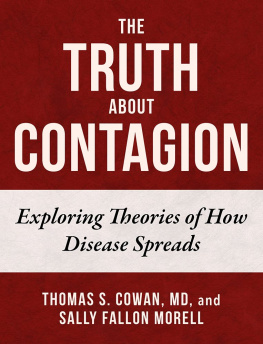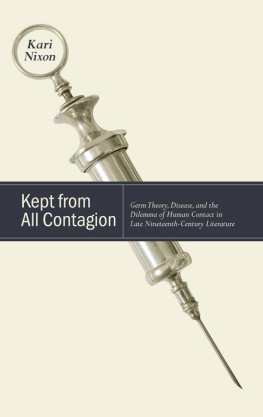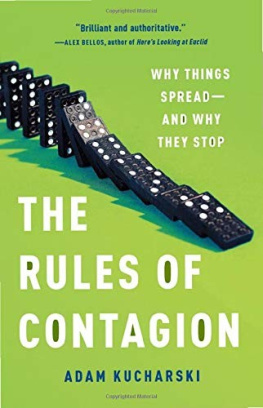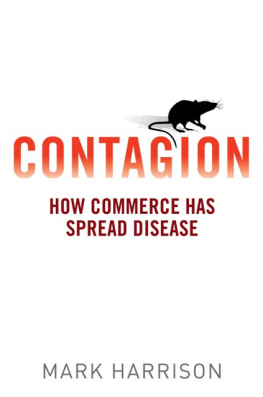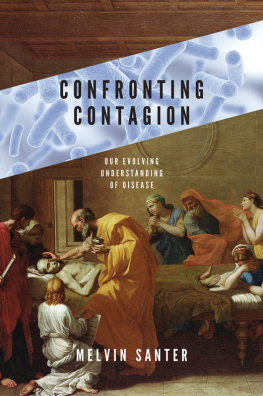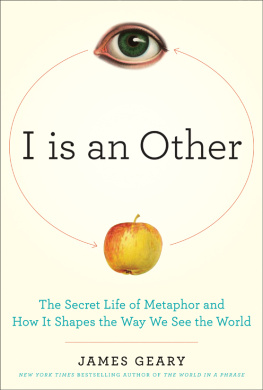Mitchell - Contagious Metaphor
Here you can read online Mitchell - Contagious Metaphor full text of the book (entire story) in english for free. Download pdf and epub, get meaning, cover and reviews about this ebook. City: London, year: 2014, publisher: Bloomsbury Publishing Plc, genre: Romance novel. Description of the work, (preface) as well as reviews are available. Best literature library LitArk.com created for fans of good reading and offers a wide selection of genres:
Romance novel
Science fiction
Adventure
Detective
Science
History
Home and family
Prose
Art
Politics
Computer
Non-fiction
Religion
Business
Children
Humor
Choose a favorite category and find really read worthwhile books. Enjoy immersion in the world of imagination, feel the emotions of the characters or learn something new for yourself, make an fascinating discovery.
- Book:Contagious Metaphor
- Author:
- Publisher:Bloomsbury Publishing Plc
- Genre:
- Year:2014
- City:London
- Rating:3 / 5
- Favourites:Add to favourites
- Your mark:
- 60
- 1
- 2
- 3
- 4
- 5
Contagious Metaphor: summary, description and annotation
We offer to read an annotation, description, summary or preface (depends on what the author of the book "Contagious Metaphor" wrote himself). If you haven't found the necessary information about the book — write in the comments, we will try to find it.
Contagious Metaphor — read online for free the complete book (whole text) full work
Below is the text of the book, divided by pages. System saving the place of the last page read, allows you to conveniently read the book "Contagious Metaphor" online for free, without having to search again every time where you left off. Put a bookmark, and you can go to the page where you finished reading at any time.
Font size:
Interval:
Bookmark:
Contagious Metaphor
Related Titles
The Imagination of Evil , Mary Evans
Melancholy and the Archive , Jonathan Boulter
Milton, Evil and Literary History , Claire Colebrook
Palimpsest: Literature, Criticism, Theory , Sarah Dillon
Contagious Metaphor
Peta Mitchell

Bloomsbury Academic
An imprint of Bloomsbury Publishing Plc
50 Bedford Square | 175 Fifth Avenue |
London | New York |
WC1B 3DP | NY 10010 |
UK | USA |
www.bloomsbury.com
First published 2012
Peta Mitchell, 2012
All rights reserved. No part of this publication may be reproduced or transmitted in any form or by any means, electronic or mechanical, including photocopying, recording, or any information storage or retrieval system, without prior permission in writing from the publishers.
Peta Mitchell has asserted her right under the Copyright, Designs and Patents Act, 1988, to be identified as Author of this work.
No responsibility for loss caused to any individual or organization acting on or refraining from action as a result of the material in this publication can be accepted by Bloomsbury Academic or the author.
British Library Cataloguing-in-Publication Data
A catalogue record for this book is available from the British Library.
ePub ISBN: 978-1-4411-0421-2
Library of Congress Cataloging-in-Publication Data
Mitchell, Peta.
Contagious metaphor/Peta Mitchell.
p. cm.
Includes bibliographical references and index.
ISBN 978-1-4411-3273-4 (hardcover) ISBN 978-1-4411-9743-6 (PDF) ISBN 978-1-4411-0421-2 (ePub) 1. MetaphorSocial aspects. 2. Metaphor in literature. 3. Contagion (Social psychology) I. Title.
P301.5.M48M58 2012
808.032dc23
2012011969
Typeset by Deanta Global Publishing Services, Chennai, India
For Alex
Contents
I am indebted to many individuals, groups and institutions, without whose support this book would not have been possible. First, I must thank my wonderful friends and colleagues in the School of English, Media Studies and Art History at The University of Queensland. In particular, I am incredibly grateful to Catriona Mills and Jane Stadler, who went beyond the call of duty both as friends and as colleagues to read drafts and offer encouragement, and to Angi Buettner, who helped me see it through to the end. I am also indebted to the Institute of Advanced Studies in the Humanities at the University of Edinburgh and to Graeme Turner and the Centre for Critical and Cultural Studies at The University of Queensland. My visiting fellowships at the IASH and the CCCS in 2009 provided me with vital time and space to develop this project. Just as importantly, they gave me access to two wonderfully interdisciplinary cohorts of scholars, with whom I could test out my ideas. Particular thanks are due to Richard Adelman, Tom Bristow, Will Christie, John Gunders, Greg Hainge, Eric Parisot, Mirjam Schaub and Andy Wells, all of whom contributed in important ways to the shape this project has taken.
A version of Chapter 2 appeared as Geographies/Aerographies of Contagion in a special Aerographies issue of Environment and Planning D: Society and Space (vol. 29, 2011, pp. 53350). I gratefully acknowledge the issue editors, Maria Fannin and Mark Jackson, for the opportunity and incentive to write the original article, and Pion Ltd., London, for granting permission to reproduce it here. I am also, of course, exceptionally grateful to the editorial staff at Bloomsbury Academic: to Anna Fleming, who saw in my proposal something worth pursuing, and to Colleen Coalter, Rachel Eisenhauer and Laura Murray, who have all helped bring this book to fruition.
Finally, my deepest debt is to my loving and long-suffering family. Alex, Mum, Dad, Rhylla and Bruce: sine quibus non .
Life no longer seems to be within us; it flows out, springs forth, is communicated as if by contagion, transmitted by a look, a tone of voice, a gesture, impressing our will on others.
Honor de Balzac, Colonel Chabert, Comdie humaine. 1832.
Contagion today is everywhere it is in the financial markets, on the streets and in our computers. It characterizes our use of social networking and the way ideas spread through society. In public and cultural discourse, catchphrases such as social contagion, emotional contagion, mental contagion, financial contagion and even cultural contagion have become prevalent, if not commonplace, suggesting contagion has moved beyond our bodies and has begun infecting our minds and our modes of interacting with and influencing others. We are used to thinking of the word contagion as having a proper or literal meaning, one that relates to the physical communication of disease. The Oxford English Dictionary , for instance, gives the primary, denotative meaning of contagion as the communication of disease from body to body by contact direct or mediate (Contagion 1989), and this is the meaning that has largely been retained in contemporary medical-scientific discourse. When compared with this literal sense of contagion, the sociocultural formations noted above begin to appear more metaphorical, more figurative.
Over the past decade, these extra-medical forms of contagion have flourished in contemporary discourse. Many have crystallized around the growth of social networking, with its attendant viral metaphors, and the global financial crisis of the late 2000s. In the latter of these two examples, news services reported not only upon the financial contagion spreading throughout Europe, but also on dangers of contagious protests and rioting in response to recession, unemployment and introduced austerity measures. Indeed, journalist Mallory (i.e. biological) virus, but it also clearly emphasizes social or affective aspects of contagion. As Simon notes, both the Greek debt crisis and Soderberghs film serve to demonstrate how affective contagion or panic spreads faster than the underlying virus (whether it be financial or biological) itself.
Soderberghs Contagion , which I will return to in the final chapter, narrates the outbreak of a fictional virus that rapidly becomes a global pandemic. The virus, named MEV-1 (meningoencephalitis virus one), is a hybrid paramyxovirus that originated when the wrong pig met up with the wrong bat, and its epidemiology is, as microbiologist and biological warfare specialist Raymond A. Zilinskas has pointed out, similar to that of the sudden acute respiratory syndrome (SARS) outbreak of 2002 (2011, n. pag.). Like SARS, MEV-1 is contracted via contact with fomites (surfaces that carry infection, such as telephones, door handles ATMs, etc.) or infectious airborne droplets caused by the sneezing or coughing of an infected person. Also like SARS, Contagion s MEV-1 is depicted as originating in China and spreading globally out from the air transport network hub of Hong Kong. And yet, this literal (though fictional) virus is not the only one brewing in Contagion , for the film foregrounds the infectious fear, panic and collapse of social order that the MEV-1 virus invokes almost as strongly as the virus itself. Indeed, one of the films theatrical release posters emphasizes affective contagion to such a degree that the physical nature of the virus is displaced from its central role. In this poster, images of the films key characters only one of whom appears to have physically contracted the virus surround a tag line in red type: Nothing spreads like fear: Contagion.
In a similar vein, Jos Saramagos 1995 novel, Blindness ( Ensaio sobre a Cegueira ), explores the complex physical, affective and social effects wrought by a mysterious, and unexplained, epidemic of blindness that takes over a city. A decade after the publication of Blindness , Saramago published a companion novel, Seeing ( Ensaio sobre a Lucidez ). Seeing is set in the same unnamed capital city as Blindness , but this time its inhabitants are struck by a different kind of contagion. In the citys elections, 70 per cent of the citizens cast blank ballots, a strange and inexplicable phenomenon that the government is quick to condemn as a moral plague that had infected a large part of the population (2007 [2004], p. 37). This sickness of the body politic, the suspicious government determines, must have a cause, and so begins the administrations unrelenting and draconian search for an instigator, a kind of patient zero, of the moral contagion.
Next pageFont size:
Interval:
Bookmark:
Similar books «Contagious Metaphor»
Look at similar books to Contagious Metaphor. We have selected literature similar in name and meaning in the hope of providing readers with more options to find new, interesting, not yet read works.
Discussion, reviews of the book Contagious Metaphor and just readers' own opinions. Leave your comments, write what you think about the work, its meaning or the main characters. Specify what exactly you liked and what you didn't like, and why you think so.

